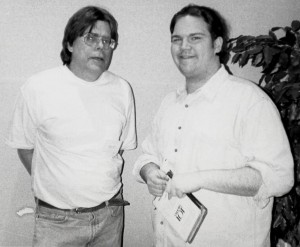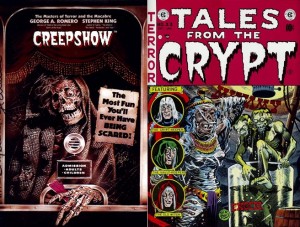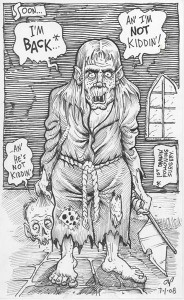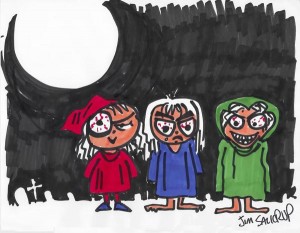Mond… err…Friday Fright Fest: Just as Real, but Not as Brightly Lit
In this special post, Matt. Murray – author of the regular Monday Media Madness column – celebrates Friday the 13th with a look at a freaky series just released to DVD and its relationship to a long dead, recently re-animated comic series.
by Matt. Murray
Tuesday February 10th marked the long-awaited release of Tales from the Darkside: The First Season to DVD. Running from 1983 to 1988, Darkside was the pinnacle of syndicated horror entertainment in the 1980s, a time when no less than five other genre shows were choking up the UHF dial after midnight on weekends. Featuring adaptations of stories by the likes of Stephen King, Clive Barker and Harlan Ellison, occasionally iconic performances by actors such as Jerry Stiller and directorial experiments from special FX guru Tom Savini, Darkside entertainingly filled a void in televised horror anthologies that was left by the canceling of The Twilight Zone
and The Outer Limits
two decades prior. It also opened the door for a new crop of programming that included the 1980’s Zone re-launch, Monsters, Freddy’s Nightmares and eventually HBO’s Tales from the Crypt.
While much better episodes pop up in later seasons (notably: “The Devil’s Advocate,” “Monsters in My Room,” “The Yattering and Jack,” “Sorry, Right Number” and “Family Reunion”), Darkside’s first season does have some highlights. Among them are a somewhat sweet-natured and nice installment called “Word Processor of the Gods”, adapted from a King story, and a personally scary (as a smoker) bit, “Bigalow’s Last Smoke.” If, like me, you’ve seen the latter and think that it bears a striking resemblance to another King story, “Quitters, Inc.”, don’t be alarmed. Considering that the series was created and produced by George A. Romero, a regular King adapter and creative partner, it’s no wonder that there wasn’t an intellectual property lawsuit filed. In fact, it was one of his first projects with King, Creepshow, that actually lead Romero to develop Tales from the Darkside for television.

Mssrs. King and Murray, c. March 1997
A collection of stories tied together by the framing device of a young kid reading a horror comic his father abhors, 1982’s Creepshow (written by King and directed by Romero), was a celebration of the horror and shock stories found in the pages of the 1950s EC titles like the original Tales from the Crypt and Vault of Horror. Further tying the film to the comics was a shrouded, skeletal “host” who popped off the page in animated bits (designed by Jack Kamen), shots which dissolved into sequential panels, and through the father/son framing story there’s an understated commentary on the Kefauver hearings which caused EC’s demise wrapped in a dramatization of that Golden/Silver age true life horror tale: “My Parents Threw Out My Comics!”

After the success of the film, apparently there was interest in developing the movie into a television program. However, since the film’s distributor owned the rights to the title and the concept, independent producers Laurel Entertainment (of which Romero was a partner with Richard Rubinstein) chose to tweak the property and rename it Tales from the Darkside, finding another way to reference the EC comics that Creepshow venerated.
While the title drew the program closer to the comics, those necessary creative tweaks drew them apart. Dropped were the panel dissolves and the Kamen illustrations, freeing the work-for-hire directors to put their own stamps on their respective episodes. Also gone was the Grim Reaper-esque host, who was replaced by ominous voice-over narrations that ran at the beginning and end of each show:
The limited series budget, no doubt doled out sparingly across each episode by no-cash kings Romero and Rubenstein, forced a focus on writing and characterization over effects and blatant gore – trends that were all the rage in contemporary cinematic horror like the Nightmare on Elm Street and Halloween films. Episodes with creatures were steeped in concealing shadows and cluttered with close-ups of monster make-ups, no doubt taken when they were freshly applied and at their scariest.
All things considered, its easy to say that Tales from the Darkside as aired came across more as an updated, low-budget Twilight Zone than a continuation of Creepshow. However, in watching the show on DVD and in its current reruns on the Sci-Fi and Chiller channels, I believe that Darkside is, in practice, actually the truest interpretation of Tales from the Crypt, even more so than the HBO “direct” adaptation which came on Darkside‘s heels.
Like Darkside, Crypt was a fairly low budget affair that its independent producer needed to tweak from its original form in order to find a commercial market. When publisher William M. Gaines reluctantly took over his deceased father’s comic book company, Educational Comics, publishers of Picture Stories from the Bible became Entertaining Comics, publishers of Crime Patrol. It was a strong reaction to a horror story in that magazine that lead it to be eventually re-titled Tales from the Crypt, having all of its content switched from cops and robbers to supernatural tales. However, the numbering system on the book didn’t change because Gaines didn’t want to have to re-solicit it or have to pay the United States Post Office a new subscription fee.
Another cost cutting method lead to a distinctive look not only for Crypt, but all of the EC books. In his book Tales from the Crypt: The Official Archives, Digby Diehl mentions that a key reason for Gaines using the distinctive Leroy lettering stylus instead of having the books had-lettered was because “both the system and its operator were inherited from his father.”
Despite running on a tight purse, EC Comics like Darkside, showcased creative plots and often adapted then current stories by the era’s best genre authors. Where Romero had King and Barker, Gaines and his editorial partner Al Feldstein had their own ace-in-the-hole, Ray Bradbury. In Tales of Terror! author Grant Geissman printed an interview in which Feldstein recounts how an unintentional “adaptation” lead to a lasting relationship with the author: “And then inadvertently, Bill sold me on a plot that I didn’t know was Ray Bradbury’s, or was close (to it.) I did the story…and then Bradbury worte to us… ‘Hey you guys neglected to pay me my royalty.’ …And Bill who was always a shrewd businessman, said ‘I’ll pay you – it was only $25 to do the adaptation – can we adapt anymore?’ And Bradbury said ‘Okay.’ This became the love of my life, adapting Ray Bradbury into comics. I did The Martian Chronicles, Golden Apple in the Sun, and for the horror I was doing The Dark Carnival.”
Also like Darkside, Crypt‘s content was decided by issues of morality imposed by the medium. Despite the fact that his titles made easy targets for Dr. Frederic Wertham and Senator Estes Kefauver, an actual look at Gaines books shows that there was very little actual gore and most of the sex and horror they were attacked for happened off panel in the much scarier landscape of the reader’s mind. This may come as a shock to those reading this who believe that HBO’s Tales from the Crypt, which itself was drenched in blood and boobs was a literal translation of the comics they took their plots from.
Even before the Comics Code all but shut down his company, Gaines found himself constrained by a set of rules laid down on his company, and in turn the entire industry, by his father in a 1942. They included, among other things: “Don’t put anybody’s eyes out;” “Show no torture scenes; show no whippings; ” and “Make killings in two panels: In one one, the villain approaching with the weapon; In two the villain leaving the body with the smoking gun.” While he gleefully busted a number of those taboos, he did exhibit some editorial boundaries.
Gaines professed in his own pages, in interviews and on the floor of the 1954 Congressional hearings that he forbade a number of images out of his own good taste and moral leanings. (A 1990s interview would reveal that one such instance was in the case of the hotly debated Crime Suspenstories #22 “decapitation” cover. In a confrontation with Kefauver and Senate Subcommittee investigators Herbert Beaser and Herbert Hannoch Gaines cited that the artwork specifically didn’t feature “the head (held) a little higher so that the neck could be seen dripping blood… and the body… seen to be bloody,” however the original Johnny Craig artwork did feature a “blood dripping from the neck” but Gaines ordered it changed. He stated: “When Kefauver asked, do I think it’s in bad taste, knowing what it had been originally, I said, ‘No, this is in Good taste.'”)
Darkside‘s cut aways which allowed viewers to fill in gaps with their own gory imaginations, came not only from a lack of budget but an adherence to the standards inflicted upon it by broadcast television censors. Considering that it was independently produced without network influence, and that it aired after midnight on the weekends, it was given more leeway to push the envelope of “good taste” slightly more than if had aired in prime time on the “Big Three.” The TV Crypt can probably blame its more-more-more sensibilities on its pay cable, anything goes original network, and the over-the-top tastes of its producers, which included Joel Silver and Robert Zemeckis, who have never been know for their story-telling subtleties. (For fun, I recommend picking up a copy of any of the EC Archives and finding a story that corresponds with an episode of Tales from the Crypt, and marvel at the differences that you never realize existed.)
Another characteristic intrinsic to both Tales from the Darkside and the original Tales from the Crypt and EC comics in general , is that while both are highly enjoyable, both also included some serious clunkers. It’s hard turning out extremely high quality work for public consumption on a schedule. Both are also definite products of their time, and do show extreme wear and tear in light of the years of growth and advancement their respective mediums have made. While this may get me in trouble with some EC purists, I feel that it’s necessary to say to put Darkside into context and move onto the final subject of this post:

There’s a new Tales from the Crypt on the comics market, and its definitely worth your read as well. In all transparency, I must state that I have numerous friends and at least two former employers who work or have worked on the book which is published by Jim Salicrup’s all ages imprint, Papercutz. However, that doesn’t mean that it’s not a horrorshow piece of consistent quality (though sometimes clunker laden – as it often accused of being) , that follows in the footsteps of its predecessors and itself features homages to all of the hard work in the genre that has paved its way. One story, by SAC’s own Jared Gniewek, could easily have been an episode of Darkside‘s television successor Monsters and that’s not a surprise considering the author’s love of late-night, syndicated horror shows.
So, next Friday the 13th – which is hey! next month – let the spirit (perhaps of Bill Gaines?) move you, and get out there and pick up a copy of Tales from the Crypt, either in the archives, or as the Papercutz floppies and digests. (Also, all seven seasons of the TV show are available on DVD as well.) Or do what I’m doing today, and lock yourself into an all day marathon of Tales from the Darkside on DVD. And, until then… try to enjoy the daylight.

All characters are property of their respective copyright holders. Creepshow and Tales from the Crypt prints and original Rick Parker and Jim Salicrup “Ghoulunatic” artwork featured in this post are currently on loan to the Sequential Art Collective from a private collection.
Matt. Murray earned his BFA in film, television and radio production from NYU. He has curated exhibits focusing on the art and commerce of Saturday Morning cartoons and the adaptation of illustrated media into live actions films and animation. Murray is the country’s leading (if not only) Smurfologist. His personal blog, It’s Time for Some Action, can be found at http://actnmatt.blogspot.com/



No comments yet.